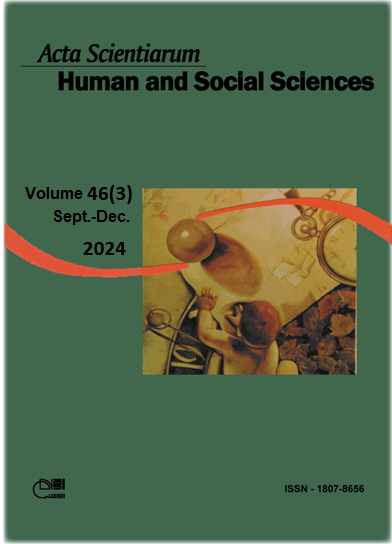Hölderlin’s dwelling life between the comic and the tragic according to Agamben’s interpretation
Abstract
This article compares the theses of Peter Szondi, Philippe Lacoue-Labarthe and Giorgio Agamben, in order to demonstrate how the latter advances in relation to those, proposing an anti-tragic turn in Hölderlin’s late production, in which he points out a comic element, whose objective is to defend the thesis that the poet applied to his own life the paradigm of the free use of own, which he mentioned in his letters to Böhlendorff. The comic, therefore, besides being opposed to the tragic, presents itself as a means for the poet to reach the dweller life, which is characterized by impersonality and in which all dichotomies are undone, especially between the comic and the tragic. Agamben uses Félix Ravaisson’s thesis On Habitude to substantiate the dweller life and its spontaneity and impersonality, that is, a life that can only be inhabited and that the poet expresses in his poems of the Tübingen tower, true idylls, according to Agamben.
Downloads
References
Referências
Agamben, G. (2022). A loucura de Höderlin – crônica de uma vida habitante 1806-1843 (W. M. Miranda, Trad.). Belo Horizonte, MG: Editora Âyiné.
Aristóteles. (2004). Poética (Prefácio de Maria Helena da Rocha Pereira; A. M. Valente, Trad.). Lisboa, PT: Fundação Calouste Gulbenkian.
Beaufret, J. (2008). “Hölderlin e Sófocles”. In Observações sobre Édipo; Observações sobre Antígona. (p. 66-94, A. L. A. Coli; M. N. Passos, Trad.). Rio de Janeiro, RJ: Editora Jorge Zahar.
Borges-Duarte, I. (2021). Cuidado e bom humor em Heidegger. Studia Heideggeriana, 10, 211-224.
Courtine, J-F. (2006). A tragédia e o tempo da história (H. B. S. Rocha, Trad.). São Paulo, SP: Editora 34.
Dastur. F. (1997). Hölderlin: le retournement natal. Paris, FR: Encre Marine.
Fischer, L. (2020). “Hölderlin’s mytopoetics: From ‘Aesthetic Letters’ to the new mythology”. In R. Tobias (Ed.), Hölderlin’s Phylosophy of nature (p. 143-163). Edimburgo, SL: Edinburgh University Press.
Frank, M. (2003). The philosophical foundations of early german romanticism (E. Millán-Zaibert, Transl.). Albany, NY: State University of New York Press.
Heidegger, M. (2012). Ensaios e conferências (8a ed., E. C. Leão; G. Fogel; M. S. C. Schuback, Trad.). Petrópolis, RJ: Vozes; Bragança Paulista, SP: Editora Universitária São Francisco.
Heidegger, M. (2013). Explicações da poesia de Hölderlin (C. P. Drucker, Trad.). Brasília, DF: Editora Universitária de Brasília.
Hölderlin, F. (1990). Correspondência completa (H. C. Gabaudan; A. L. Coello, Trad.) Madrid, ES: Ediciónes Hiperión.
Hölderlin, F. (1992). Sämtliche Werke und Briefe - Vol. II (Herausgegeben von Michael Knaupp). Munique, DE: Carl Hanser Verlag München Wien.
Hölderlin, F. (2003). Hipérion ou O eremita na Grécia (E. J. Paschoal, Trad.). São Paulo, SP: Nova Alexandria.
Hölderlin, F. (2020). Fragmentos de poética e estética (U. R. Vaccari, Trad.). São Paulo, SP: Editora da Universidade de São Paulo.
Lacoue-Labarthe, P. (2005). “A cesura do especulativo”. In Textos sobre Hölderlin (p. 31-71, J. Afonso, Trad.). Portugal, PT: Edições Vendaval.
Schiller, Friedrich. (1991). Poesia ingênua e sentimental (M. Suzuki, Trad.). São Paulo, SP: Iluminuras.
Machado. R. (2006). O nascimento do trágico: de Schiller a Nietzsche. Rio de Janeiro, RJ: Jorge Zahar Ed.
Szondi, P. (2004). Ensaio sobre o trágico (P. Süssekind, Trad.). Rio de Janeiro, RJ: Jorge Zahar Ed.
Ravaisson, F. (2008). Of Habit. Preface by Catherine Malabou (C. Carlisle; M. Sinclair, Transl.). London/New York: Continuum International Publishing Group.
DECLARATION OF ORIGINALITY AND COPYRIGHTS
I Declare that current article is original and has not been submitted for publication, in part or in whole, to any other national or international journal.
The copyrights belong exclusively to the authors. Published content is licensed under Creative Commons Attribution 4.0 (CC BY 4.0) guidelines, which allows sharing (copy and distribution of the material in any medium or format) and adaptation (remix, transform, and build upon the material) for any purpose, even commercially, under the terms of attribution.
Read this link for further information on how to use CC BY 4.0 properly.























